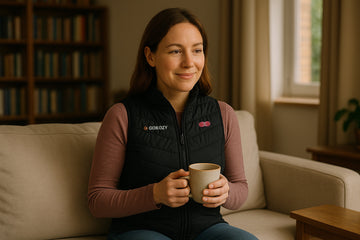Most people picture a heated vest on frosty trails or football sidelines—but more and more folks use one indoors to stay comfortable without cranking the thermostat. This guide explains when it makes sense, how to wear a heated vest safely at home or the office, and simple habits that keep you warm while saving energy.
Why People Wear Heated Vests Indoors
- Energy savings: Personal warmth often costs less than heating an entire room or home.
- Drafty or over-cooled spaces: Offices, studios, basements, and garages can feel chilly even when the weather isn’t extreme.
- Comfort without bulk: Core heat keeps you cozy while your arms stay free for typing, cooking, crafting, or childcare.
- Adjustable warmth: Multi-level heat lets you fine-tune comfort minute by minute.
Is It Safe to Wear a Heated Vest Indoors?
Low-Voltage, Everyday-Safe Design
Quality heated vests run on low voltages (commonly 5V or 7.4V) and use flexible carbon-fiber heating elements that deliver gentle, even warmth. They’re designed for daily use—indoors and out—without the hot spots you might get from direct-contact heat packs.
Built-In Protections
- Overheat protection: Controllers regulate output and help prevent excessive temperatures.
- Battery safeguards: Using the supplied power bank and cable helps maintain safe, stable performance.
- Care guidance: Remove the battery before washing; never modify wiring or ports.
When to Check with a Clinician
If you have implanted medical devices (e.g., a pacemaker) or a condition that affects heat sensitivity, ask your healthcare professional for personalized advice before regular use.
Indoor Benefits: Comfort You Can Control
- Targeted warmth: Heating your core helps the rest of your body feel comfortable without heavy layers.
- Less layering, more mobility: Stay productive at a desk or workbench without bulky sleeves.
- Quick warm-up: Pre-heat on High for a few minutes, then drop to Medium/Low to maintain comfort.
- Quiet and discreet: Minimalist styling fits in at home or office without drawing attention.
Best Indoor Scenarios for Heated Vests
Working from Home
Long keyboard sessions can leave you chilled—especially when you nudge the thermostat down to save energy. A heated vest stabilizes your core so your hands stay nimble and focus stays sharp.
Office Environments
Open-plan floors and meeting rooms are often over-cooled. A slim vest layers neatly under a blazer or knit and won’t restrict movement during commutes or desk work.
Basements, Garages, and Studios
DIY projects and hobbies in semi-conditioned spaces are far more pleasant with steady core warmth—no need for a space heater at your feet.
Evening Wind-Downs
Reading, gaming, or watching TV? Keep comfort personal and steady without heating the whole room.

How to Use a Heated Vest Indoors the Right Way
Layering That Works
- Base: Light, moisture-wicking long sleeve or tee (synthetic or merino).
- Vest: Wear your heated vest snug—not tight—so warmth transfers efficiently.
- Optional top layer: A thin knit or blazer if your space is drafty.
Smart Heat Settings
- Use High for 5–10 minutes to warm up quickly.
- Switch to Medium or Low to maintain comfort while saving battery.
- Dial down during movement; increase a notch when you sit still.
Battery Tips Indoors
- Charge fully before use and keep a spare power bank handy for long sessions.
- Store batteries at moderate room temperature; avoid heaters, sunlight, or damp areas.
- Use the recommended charger; avoid unverified fast-charging adapters.
Cleaning & Care
- Always remove the battery before washing.
- Follow the care label; when unsure, use a laundry bag and a gentle, cold cycle.
- Air-dry flat; avoid tumble drying, bleach, and dry-cleaning solvents.
What to Avoid Indoors
- Sleeping in it: Don’t wear a heated vest to bed; switch off and remove it before sleep.
- Covering with heavy blankets on High: Trapping excess heat can be uncomfortable—reduce the setting.
- Using damaged gear: If the cable, port, or battery looks compromised, stop and replace.
- Wetting the electronics: Keep battery and connectors dry; remove the pack before spot cleaning.
FAQs
Can a heated vest help lower heating bills?
Yes. Personal warmth lets you run the thermostat lower while staying comfortable—especially during sedentary tasks like reading or computer work.
Will a heated vest interfere with my phone or laptop?
No. The low-voltage system doesn’t interfere with typical consumer electronics. Keep cables tidy to avoid snags while working.

Is it okay to use it all day?
Many people do. Take short breaks, adjust heat to the lowest comfortable setting, and swap batteries for extended sessions.
Can kids or seniors use heated vests indoors?
Seniors often find the lightweight warmth helpful. For children, supervise use and start on the lowest setting. Anyone with heat sensitivity or implanted medical devices should consult a clinician first.
Bottom Line
Wearing a heated vest indoors is a smart, safe way to stay comfortable without heavy layers or high energy bills. Start warm, dial it back, and keep your setup simple. If you’re ready to make chilly rooms a non-issue, explore GOKOZY’s heated vests—lightweight, easy to use, and built for everyday life.
::contentReference[oaicite:0]{index=0}






